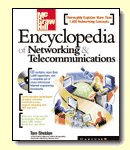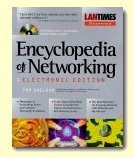|
Site home page
(news and notices)
Get alerts when Linktionary
is updated
Book updates and addendums

Get info about the Encyclopedia of Networking
and Telecommunicatons, 3rd edition (2001)

Download the electronic version of the Encyclopedia
of Networking, 2nd edition (1996). It's free!
Contribute to this site
Electronic licensing info
|
|
Service Advertising and Discovery
Related Entries Web Links New/Updated Information
Note: Many topics at this site are reduced versions of the text in "The Encyclopedia of Networking and Telecommunications." Search results will not be as extensive as a search of the book's CD-ROM.
Services on networks can be advertised so that users can discover them. A number of protocols and schemes are available to support service advertising and discovery. For example, service advertising and discovery is important as mobile devices and mobile wireless devices proliferate on networks. These devices may connect to networks at varying locations. A service discovery and advertising protocol is an important tool to help these devices find services on the network wherever they connect, and to let other network users know about the services they are offering.
Keep in mind that as networks evolve, a variety of services will be offered. For example, network services such as file, print, and applications services can be advertised to "foreign" mobile users who temporarily connect to a network. But other possibilities exist, especially in the wireless realm. For example, an airport could have numerous small wireless networks that are limited in range to about 10 or 20 feet. As you walk into the range of one of these networks, various service advertisements appear on your portable device. These may be advertisements for peripherals like printers that you can use, but they could also be commercial advertisements.
If you are familiar with instant messaging, you are familiar with service advertising protocols. When a person in your "buddy list" signs on to the network, you receive an alert and you can start chatting with them over the network via special chat software, Internet phone, or videoconferencing software. In the case of the airport wireless networks mentioned previously, advertising protocols can alert you to friends who are located in the general vicinity. Their wireless device is advertising their personal ID and your wireless device listens for IDs and looks them up in your personal address book. If a friend is nearby, your device gets excited and starts beeping.
Two earlier advertising services that were developed for LAN environments include SAP (Service Advertising Protocol) and NetBIOS (Network Basic Input/Output System). These are discussed under their own heading.
A number of new approaches have been developed to provide enhanced service advertising and discovery in dynamic network environments such as the wireless and mobile computing networks, where devices frequently connect and disconnect from the network. When a device comes online, it advertises its services or listens for advertisements of available services.
One technique a device may use to locate a service on the network is to send out a multicast packet that contains a service request. Network devices that are providing services listen for multicast packets and then determine whether they can satisfy the request for services being made by the client. If so, the service will respond to the client with a positive message.
Here are some architectures and schemes related to service discovery, advertising, and acquisition:
- Salutation
The Salutation architecture is a royalty-free service discovery and service management product from the Salutation Consortium, a nonprofit corporation. Salutation is an open standard, independent of operating system, communications protocol, hardware platform, or vendor-imposed limitations. It was created to provide service discovery for a broad range of network appliances and equipment in a platform-, OS-, and network-independent environment. Devices can use it to advertise and describe their capabilities and discover the capabilities of other devices by using search features.
- SLP (Service Location Protocol)
SLP is an IETF standard designed to make it easy for network clients to discover the available services on a network and learn information about the configuration of those services. Many vendors support SLP in their operating systems, including Apple, IBM, Novell, and Sun Microsystems. The IETF Service Location Working Group is developing SLP and similar services. See "SLP (Service Location Protocol)."
- Microsoft.NET
The Microsoft.NET platform for Web Services is a development environment based on building applications with "Web Services." The technique is similar to building distributed objects, but is based on HTTP and XML. Data is represented with XML and delivered in SOAP (Simple Object Access Protocol) messages via HTTP. A language called WSDL (Web Services Description Language) is used to describe services. An XML-based protocol called Disco is used to discover services at a site and a mechanism called UDDI (Universal Description, Discovery, and Integration) defines how to advertise services and how Web Service consumers can find services. See Microsoft.NET.
- SSDP (Simple Service Discovery Protocol)
SSDP is a Microsoft service location protocol that is part of Microsoft's Universal Plug and Play (UpnP) initiative. It is oriented toward home networks. Like SLP, it enables devices to request information about services on a network and to advertise their presence and the services they offer.
- Bluetooth
This is a wireless connectivity specification that enables electronic devices to talk spontaneously and allows instant wireless connectivity between computers, mobile phones, and portable devices. Bluetooth includes its own service discovery protocol that locates services offered by devices within the vicinity of a user's Bluetooth device. Currently, Bluetooth's service discovery protocol is being mapped to the Salutation architecture. See "Bluetooth."
- Jini
This is a Java-based technology defined by Sun Microsystems. When Jini-enabled devices connect to networks, they establish impromptu Java-oriented networks that let users immediately access network resources and services. The technology is designed to support any device that "passes digital information in or out" according to Sun. Devices register with the network when they connect, which makes them available to other devices. For example, when a printer is attached and gets registered, it makes its driver available on the network and this driver gets downloaded to clients when they need to use the printer.
- JetSend (Hewlett-Packard)
JetSend is code that is embedded in devices to allow them to directly exchange information. Devices become either senders or receivers. JetSend gives devices the intelligence to know their own capabilities and negotiate the best way to exchange information with other devices. No external operating systems need to get involved. No special drivers are needed to connect with other devices. All JetSend devices can immediately communicate. JetSend is a transport-independent protocol that works across any bidirectional transport, including TCP/IP, IR, IEEE 1394, and others. It is ideal for PDAs, digital cameras, copiers, network-attached printers and scanners, fax machines, and other devices.
- Inferno
by Lucent Technologies A real-time network operating system that provides a software infrastructure for creating distributed network applications. Inferno is more like a file system that operates over a variety of transport protocols. It is designed to provide connectivity over the Internet, public telephone networks, cable television, and satellite broadcast networks. Inferno includes network and security protocols. It has a very small memory footprint and can be used as a stand-alone OS on information appliances.
A lot of the work being done in this area is for home networking and network appliance configuration. In particular, Jini and Microsoft's UPnP are designed to help devices connect and cooperate.
The IETF Resource Capabilities Discovery (rescap) Working Group is developing services that distribute information about resources or services to the global Internet. The IETF Service Location Protocol (svrloc) Working Group has developed procedures for discovering services.
Copyright (c) 2001 Tom Sheldon and Big Sur Multimedia.
All rights reserved under Pan American and International copyright conventions.

|

